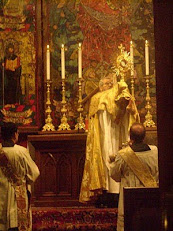
The web site of the Personal Ordinariate of the Chair of St. Peter has published its particular calendar and sanctorale. Like the Personal Ordinariate of Our Lady of Walsingham in England and Wales, this calendar has the following differences from the Roman Calendar:
- The term "Ordinary Time" is not used of the Sundays. Sundays following the Christmas season are named "Sundays After Epiphany", while the three Sundays before Ash Wednesday regaining their historic names of Septuagesima, Sexagesima and Quinquagesima.
- The Sundays following the Easter season and the feast of the Most Holy Trinity are named "Sundays After Trinity", according the practice of northern Catholicism in general and the Church of England in particular.
- The Rogation Days before the feast of the Ascension are restored.
- Observance of the Octave of Pentecost is restored (in vestments and propers, but using the weekday readings from the Roman Lectionary).
- The Ember Days, at their traditional times, are restored.
- The first Sunday of October is permitted to be used for a parish's dedication festival, if the date of the dedication is unknown
The Calendar specifies that the Sundays After Epiphany will use the Roman Lectionary, and so Second Sunday after Epiphany would use the readings for the Second Sunday in Ordinary Time; and the Sundays After Trinity will use the Lectionary readings from the weeks of Ordinary Time.
In the Sanctorale, several feast days are added to the US calendar, and some feasts of the US calendar are raised in rank: The Chair of St. Peter on February 22 becomes a Solemnity. Our Lady of Walsingham on September 24th is added to the calendar as a Feast, and Our Lady of the Atonement is added to the calendar on its traditional day of July 9th as an optional memorial.
Download the Calendar and Sanctorale at this link.














This is wonderful. If you want to see what a reformed Ordinary Form calendar would look like (with an overweight on British saints), this is it.
ReplyDeleteThe ordinariate will be a second front in the war. The traddies have been manning one front for awhile. This opens up a whole new salvo. The forces of rupture and liturgical abuse have seen a dark day, indeed.
I cant wait for my Parish to become and Official part of the Ordinariate. johnofthecrumbs
ReplyDelete"The Calendar specifies that the Sundays After Epiphany will use the Roman Lectionary"......
ReplyDeleteI thought the Ordinariate already had its own Lectionary. I bought one for myself and ond one that went to the Ordinariate group in Scotland.
Rome meddling already?
Basically what I'd like the calendar to be in my run of the mill parish. Nicely done, Ordinariates.
ReplyDeleteThe Lectionary, Matthew, that I think you are referring to is the one that uses Scripture from the Revised Standard Version-CE? We use that at St. Athanasius in Boston. However, it is the same lessons (just a different, and superior, translation) as is used by the Ordinary Form of the Roman Rite, which in the US uses the New American Bible (revised).
ReplyDeleteThat lectionary became available because the Bishops Conference of the Antilles (West Indies) approved it for use and Ignatius Press published it. Perhaps, now that it is allowed for the Ordinariates, Ignatius will resume publication.
I believe that the Ordinariate in Enlgand & Wales does have its own Lectionary for the Divine Office (Mattins and Evensong). That is a separate and distinct lectionary, and is not the one being referred to in this post. The US Ordinariate currently would follow the Office Lectionary in the Book of Divine Worship.
Where do we stand now on Ordinariate texts for the Daily Office and lectionary readings? I am a member but don't live anywhere near an Ordinariate parish. Is there an Ordinariate Daily Office text aside from the BDW yet? And what lectionary are Ordinariate parishes reading during mass? I keep seeing online references to the RSV Catholic Edition being approved for Ordinariate Use... But where is that explicitly stated? The USCCB site still persists in its declaration that only the Revised Lectionary may be used in the U.S. The U.K. Ordinariate site does say that only the RSV Second Catholic Edition may be used in its liturgies. Is that what's read here? And if so, has that been formally approved? The CSP site is silent on the matter.
ReplyDelete